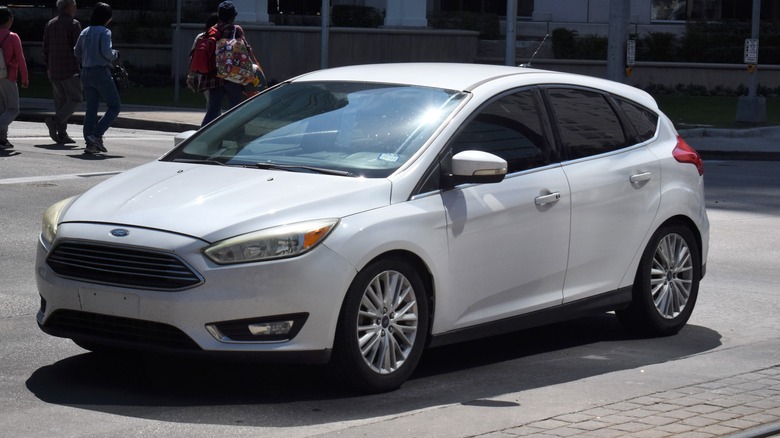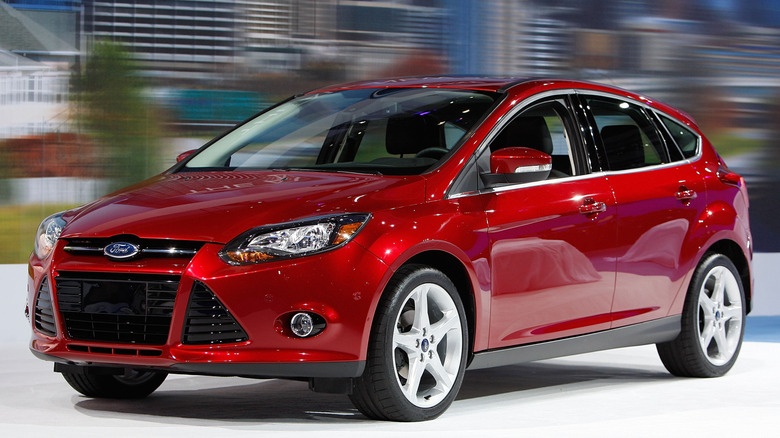Why Did Ford Discontinue The Focus?
Seeking to continue its battle with the Toyota Corolla, Honda Civic, and other Japanese compacts, Ford debuted the Focus in the U.S. for the 2000 model year. Eventually taking the place of the Escort, the Focus was the Blue Oval's attempt at a world car that could be efficiently sold in multiple global markets. The effort paid off, with the model quickly rising in the sales charts. For the 2000 calendar year, American consumers snapped up over 286,000 examples. This was at a time when passenger cars, like the Taurus, still dominated the company's lineup. By 2012, the Focus would become the best-selling car worldwide. While Ford fans still dream of a comeback, rumors of a 2025 Focus RS are likely wishful thinking rather than a sign of revival.
Of course, nothing lasts forever in the automotive world. A change in consumer preferences and corporate restructuring would eventually lead to the demise of the Focus. Following the rise of SUVs and trucks as everyday vehicles, Ford axed the Focus in the U.S. after 2018. European production will stop entirely this fall. Other casualties in Ford's housecleaning included the Fusion, Fiesta, and Taurus. Part of Ford's reasoning for exiting the passenger car business (except for the Mustang) is to shift resources to more profitable crossovers and pickups.
The rising and falling star of the Ford Focus
From the outset, the Ford Focus gained attention as more than basic transportation. In its debut year, Edmunds called the 2000 edition "one of the best small cars your money can buy." Thanks to European tuning and sharp handling, buyers got more than just econobox features, despite its wallet-friendly pricing. At the same time, Ford took a something-for-everyone approach, offering the Focus in sedan, wagon, and hatchback variants. The Ford Focus Electric arrived in 2012 and lasted throughout the third generation. However, its range never topped 115 miles, making this EV less compelling.
Enthusiasts could also get into the action with the launch of the performance-oriented 2013 Focus ST, which was equipped with a 252-horsepower 2.0-liter turbocharged four-cylinder engine and a six-speed manual gearbox. Ford then dialed up the bonkers factor by bringing the RS edition to the U.S. for 2016. Its turbo 350-horsepower 2.3-liter engine and all-wheel drive could propel this pocket rocket from zero to 60 mph in a very rapid 4.6 seconds. In a review of the 2017 Ford Focus RS, SlashGear called this a "car that beckons you on to greater levels of (legal) hooliganism".
Between multiple variants and three generations (four generations overseas), Ford threw everything it had into making the Focus successful. While the model had annual six-figure results in the U.S., sales never surpassed the 2000 peak. In 2018, only 114,000 units left U.S. dealer showrooms, validating that the market was shifting to other body styles.
Profit margins and the end of the line
While falling sales were part of the last chapter of the Focus's story, the desire to improve return on investment also comes into play. Compact vehicles like the Focus are less profitable than larger and pricier SUVs and trucks. In a 2012 report, Morgan Stanley estimated that 90% of Ford's global profits came from the F series. Ford, in effect, confirmed this in 2018 when then-CEO Jim Hackett announced the radical shift in the automaker's lineup moving forward. "We'll restructure as necessary, and we'll be decisive," he said. Hackett added, "We're going to feed the healthy part of our business."
While the Ford Focus Electric was an early attempt by the company to dip its toe in the EV waters, the current uncertainty surrounding the electric vehicle segment means a more modern version is unlikely to be released. In addition, as production winds down for the European Focus, Ford is in the process of reducing staff at the German production facility, further cementing the Focus's place as another nameplate for the history books.


